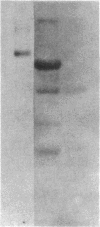Abstract
Thrombomodulin is an endothelial cell membrane protein that is a cofactor required for the rapid activation of plasma protein C. We now report that plasma and urine of normal subjects contains a modified form of thrombomodulin that is soluble. The levels measured by radioimmunoassay were 292 +/- 60 ng thrombomodulin/ml plasma and 102 +/- 38 ng thrombomodulin/ml urine. Thrombomodulin was isolated from both plasma and urine by immunoaffinity chromatography using a polyclonal anti-human thrombomodulin IgG column. The apparent molecular weight of soluble thrombomodulin was estimated by immunoblot analysis using 125I-monoclonal anti-thrombomodulin IgG. When run without 2-mercaptoethanol, soluble thrombomodulin appeared as two polypeptides, Mr = 63,000 and 54,000, while samples run with 2-mercaptoethanol migrated mainly at Mr = 85,000. These results imply that the soluble form of thrombomodulin is smaller than the cellular form, presumably because of a lack of the membrane-binding domain. Soluble thrombomodulin is similar to cellular thrombomodulin in its intrinsic protein C-activating cofactor activity as measured by antibody neutralization. The apparent Km for protein C was the same for cellular and soluble thrombomodulin, while the soluble form requires a higher concentration of thrombin (three- to fivefold) for one-half maximal activity than the cellular form. Thrombomodulin functional activity cannot be directly measured in plasma because of some inhibitory substance(s). The physiological significance of circulating and urinary thrombomodulin is presently obscure.
Full text
PDF



Images in this article
Selected References
These references are in PubMed. This may not be the complete list of references from this article.
- Burnette W. N. "Western blotting": electrophoretic transfer of proteins from sodium dodecyl sulfate--polyacrylamide gels to unmodified nitrocellulose and radiographic detection with antibody and radioiodinated protein A. Anal Biochem. 1981 Apr;112(2):195–203. doi: 10.1016/0003-2697(81)90281-5. [DOI] [PubMed] [Google Scholar]
- Esmon N. L., Owen W. G., Esmon C. T. Isolation of a membrane-bound cofactor for thrombin-catalyzed activation of protein C. J Biol Chem. 1982 Jan 25;257(2):859–864. [PubMed] [Google Scholar]
- Kisiel W. Human plasma protein C: isolation, characterization, and mechanism of activation by alpha-thrombin. J Clin Invest. 1979 Sep;64(3):761–769. doi: 10.1172/JCI109521. [DOI] [PMC free article] [PubMed] [Google Scholar]
- Laemmli U. K. Cleavage of structural proteins during the assembly of the head of bacteriophage T4. Nature. 1970 Aug 15;227(5259):680–685. doi: 10.1038/227680a0. [DOI] [PubMed] [Google Scholar]
- Maruyama I., Bell C. E., Majerus P. W. Thrombomodulin is found on endothelium of arteries, veins, capillaries, and lymphatics, and on syncytiotrophoblast of human placenta. J Cell Biol. 1985 Aug;101(2):363–371. doi: 10.1083/jcb.101.2.363. [DOI] [PMC free article] [PubMed] [Google Scholar]
- Maruyama I., Salem H. H., Ishii H., Majerus P. W. Human thrombomodulin is not an efficient inhibitor of the procoagulant activity of thrombin. J Clin Invest. 1985 Mar;75(3):987–991. doi: 10.1172/JCI111800. [DOI] [PMC free article] [PubMed] [Google Scholar]
- Mellman I. S., Unkeless J. C. Purificaton of a functional mouse Fc receptor through the use of a monoclonal antibody. J Exp Med. 1980 Oct 1;152(4):1048–1069. doi: 10.1084/jem.152.4.1048. [DOI] [PMC free article] [PubMed] [Google Scholar]
- Miletich J. P., Jackson C. M., Majerus P. W. Properties of the factor Xa binding site on human platelets. J Biol Chem. 1978 Oct 10;253(19):6908–6916. [PubMed] [Google Scholar]
- Owen W. G. Evidence for the formation of an ester between thrombin and heparin cofactor. Biochim Biophys Acta. 1975 Oct 20;405(2):380–387. doi: 10.1016/0005-2795(75)90103-8. [DOI] [PubMed] [Google Scholar]
- Salem H. H., Maruyama I., Ishii H., Majerus P. W. Isolation and characterization of thrombomodulin from human placenta. J Biol Chem. 1984 Oct 10;259(19):12246–12251. [PubMed] [Google Scholar]
- Suzuki K., Stenflo J., Dahlbäck B., Teodorsson B. Inactivation of human coagulation factor V by activated protein C. J Biol Chem. 1983 Feb 10;258(3):1914–1920. [PubMed] [Google Scholar]
- Wolinsky H. A proposal linking clearance of circulating lipoproteins to tissue metabolic activity as a basis for understanding atherogenesis. Circ Res. 1980 Sep;47(3):301–311. doi: 10.1161/01.res.47.3.301. [DOI] [PubMed] [Google Scholar]



